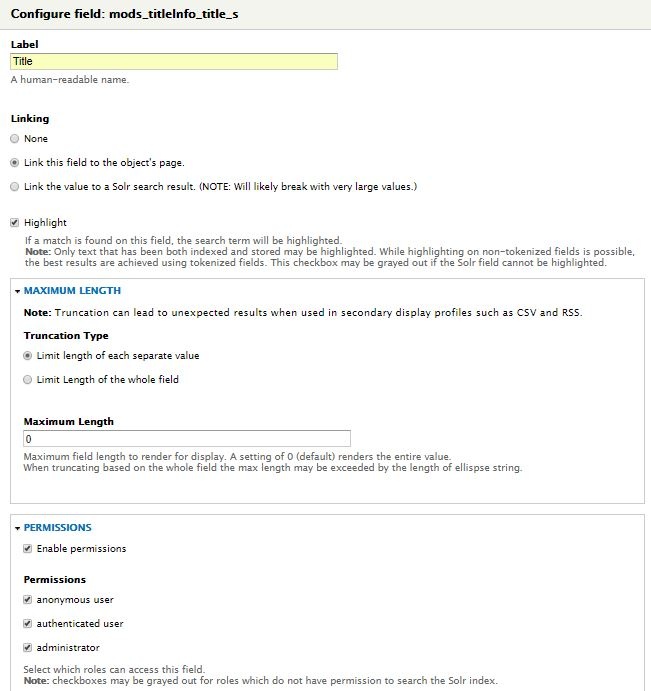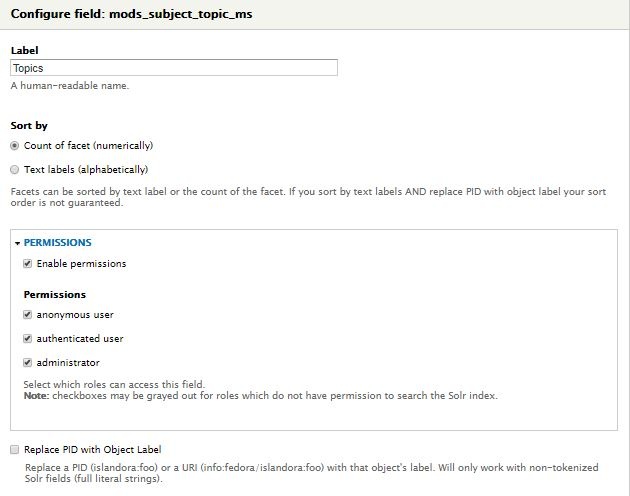...
- In the "Add another item" box, begin typing a Solr field name (the box will provide suggestions as you type). You may use multi-valued Solr fields. See Appendix D for a list of eligible field names.
- Click Add to add the field to the display.
- Once a field has been added, click Configure for more options. Different Solr field types will have different options for configuration.
- Label: Enter a user-friendly display label to represent the field in the search results.
- Linking: Link this field to the object it describes (use for fairly unique values, like titles or identifiers). With some fields it can be used as a link to perform a new Solr search based on the value of the field (such as author names, subject terms, or series titles for a related items search).
- Highlight: Check this box to enable highlighting the search term in the field(s) where it is found (keyword in context). Only works on tokenized Solr fields. See Appendix D where this is explained.
- Maximum length: Truncate field values in the search results display. Especially useful for potentially long fields such as notes, descriptions, and full text fields.
- Permissions: Specify user roles that should have access to this field.
Configure Display fields
 Image Modified
Image Modified
Limit results to field listed above?
...
- Advanced results per page
- Lets you offer users that choice of how many items in a results set to display on a page, say, "10,20,50,100".
- The options appear as bullet list of links in a block.
- You can expose this function to users by adding the Islandora search result limit block to a region in admin/structure/block.
- Field value separator
- Specify here what character(s) you want to appear between values in the multivalued fields set up in the Display fields section above.
- If left empty it will default to ", ".
- Truncated field value separator
- If you have very long values in any of your multivalued fields, you can specify here how to separate them.
- The default is set to "<br />", but if left empty it will default to line break.
Enable search navigation block
...
- Minimum limit: There must be at least this number of values in the search results before the facet will display on the search results page. A higher minimum limit will result in fewer facets displaying.
- Soft limit: The number of facet values to display before the "Show more" link appears. If you enter 0, all facet values between the minimum and maximum limits will be displayed.
- Maximum limit: The maximum number of values to display for each facet. Entering 20 would display the 20 most frequently occurring values in each facet and a "Show more" link would be automatically added to provide access to the rest of the values.
Configure Facet Fields
You can now choose between having the facets display in the order of most frequent to least frequent and having them display alphabetically. This works for date facets as well.
Replace PID with Object Label - [This option needs a more user-friendly description here].

Advanced search block
This is where you can build search queries that target specific Solr fields. The "Islandora simple search" block, by contrast, searches across a broad set of fields which you can configure here under Query defaults > Query fields.
...
- Allow Preservation of Filters
- If checked, this option will display a checkbox in the Islandora advanced search block. After a user performs a Solr search and has selected a facet to filter the search results, they can perform a new Solr search and preserve that facet selection by checking the "Preserver Filters" checkbox.
- The checkbox is not sticky and must be selected for each search performed.
- You must have the Islandora advanced search block enabled in a Drupal page region.
- Human-friendly Current Query
- If checked, this option will convert a Solr query into a more readable version.
- To see this in action you need to enable the Islandora query block.
- So, for example, instead of displaying "mods_titleInfo_title_t:(correspondence)" the query would appear as "Title:(correspondence)".
- Escape Lucene special characters
- If you need a description of this field you probably should not be using it.

Query defaults
This menu contains settings that apply to all Solr queries in Islandora.Be careful with the "Solr field for default query" because it doesn't check to see the field actually exists. The Solr field must not be a multivalued Solr field, thus, it cannot be a Dublin Core field. Note also that this setting requires "asc" of "desc" in addition to the Solr field name.
Limit results to specific namespaces - Installations of Islandora that have namespace restrictions must enter the namespaces here to restrict the search results to only the relevant namespaces. You can enter more than one namespace.
Sort field for default query - Example: To set the Solr field for the MODS title element as the sort field with the ascending order specified, add this: mods_titleInfo_title_s asc
- Be careful with the "Solr field for default query" because it doesn't check to see if the field actually exists in Solr. The Solr field must not be a multivalued Solr field, thus, it cannot be a Dublin Core field. Note also that this setting requires "asc" of "desc" in addition to the Solr field name.
Solr base filter - Example: To prevent collection-level objects from appearing in Solr search result sets, you could add this: -RELS_EXT_hasModel_uri_s:"info\:fedora\/islandora\:collectionCModel"
...
